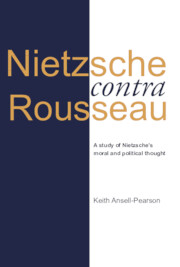Book contents
- Frontmatter
- Contents
- Preface
- Note on the texts and list of abbreviations
- Introduction
- 1 Nietzsche contra Rousseau
- 2 Civilization and its discontents: Rousseau on man's natural goodness
- 3 Squaring the circle: Rousseau on the General Will
- 4 Nietzsche's Dionysian drama on the destiny of the soul: on the ‘Genealogy of Morals’
- 5 Zarathustra's descent: on a teaching of redemption
- 6 Bending the bow: great politics, or, the problem of the legislator
- Conclusion
- Notes
- Bibliography
- Index
5 - Zarathustra's descent: on a teaching of redemption
Published online by Cambridge University Press: 03 May 2011
- Frontmatter
- Contents
- Preface
- Note on the texts and list of abbreviations
- Introduction
- 1 Nietzsche contra Rousseau
- 2 Civilization and its discontents: Rousseau on man's natural goodness
- 3 Squaring the circle: Rousseau on the General Will
- 4 Nietzsche's Dionysian drama on the destiny of the soul: on the ‘Genealogy of Morals’
- 5 Zarathustra's descent: on a teaching of redemption
- 6 Bending the bow: great politics, or, the problem of the legislator
- Conclusion
- Notes
- Bibliography
- Index
Summary
All history is sacred … the universe is represented in a moment of time.
Emerson, ‘The Over-Soul’ (1841)The Tao which can be spoken is not eternal Tao.
Tao Te ChingINTRODUCTION
It cannot be without significance that the climatic points of several of Nietzsche's major works culminate in a prefiguration of Zarathustra. In Twilight of the Idols Zarathustra appears at the end of Nietzsche's terse history of Western metaphysics which results in the abolition of any distinction between a true world and an apparent world. It is the moment at which man experiences the end of the longest error and the zenith of mankind. At the end of the second inquiry of the Genealogy of Morals, in sections 24 and 25, Zarathustra is referred to as ‘the redeeming man’ who may bring home the redemption of man the sick animal; he is the man of the future who will redeem humanity from nihilism by teaching the liberation of the will; he is the victor over God and nothingness. The justification for reading Thus Spoke Zarathustra (1883–85) after the Genealogy of Morals (1887) stems from the key role that Nietzsche assigns to Zarathustra as a teacher of redemption who appears at a certain juncture in man's evolution to deliver a teaching of redemption. It is a teaching about the nature of time and history designed to show how nihilism can be overcome and a Dionysian affirmation and celebration of life attained.
- Type
- Chapter
- Information
- Nietzsche contra RousseauA Study of Nietzsche's Moral and Political Thought, pp. 152 - 199Publisher: Cambridge University PressPrint publication year: 1991



